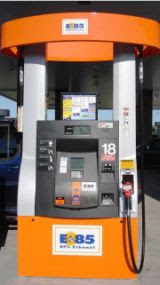 August ethanol production ended higher with 842,478,000 gallons produced, up from 799,764,000 gallons produced in July.
August ethanol production ended higher with 842,478,000 gallons produced, up from 799,764,000 gallons produced in July.Ethanol imports were up with 81,102,000 gallons imported in August versus 57,120,000 gallons in July.
August ethanol stocks ended higher at 625,044,000 gallons compared to 553,812,000 gallons in July.
Ethanol Production Numbers in Gallons | ||||
|---|---|---|---|---|
Production | Imports | Stocks | Consumption | |
August 2008 | 842,478,000 | 81,102,000 | 625,044,000 | 852,348,000 |
July 2008 | 799,764,000 | 57,120,000 | 553,812,000 | 819,840,000 |
June 2008 | 736,848,000 | 65,982,000 | 516,768,000 | 791,910,000 |
May 2008 | 778,806,000 | 36,372,000 | 505,848,000 | 793,968,000 |
April 2008 | 708,456,000 | 60,942,000 | 484,638,000 | 763,182,000 |
March 2008 | 730,674,000 | 15,456,000 | 478,422,000 | 707,238,000 |
February 2008 | 631,050,000 | 20,286,000 | 439,530,000 | 660,114,000 |
January 2008 | 664,356,000 | 20,790,000 | 448,308,000 | 679,308,000 |
December 2007 | 636,762,000 | 8,904,000 | 442,470,000 | 674,352,000 |
November 2007 | 602,592,000 | 16,506,000 | 471,156,000 | 628,800,000 |
October 2007 | 588,756,000 | 41,916,000 | 480,858,000 | 635,124,000 |
Source: - Energy Information Administration
 The American Coalition for Ethanol's blog Ethanol. Right. Now. is reporting that the number of ethanol blender pumps across the country have reached a total of 84. Blender pumps allow drivers of flex fuel vehicles to choose from several different levels of ethanol concentration such as E20, E30, E50 as well as E85.
The American Coalition for Ethanol's blog Ethanol. Right. Now. is reporting that the number of ethanol blender pumps across the country have reached a total of 84. Blender pumps allow drivers of flex fuel vehicles to choose from several different levels of ethanol concentration such as E20, E30, E50 as well as E85. Since August 2007, the Department of Energy (DOE) has been testing intermediate ethanol blends, primarily E15 and E20 in conventional vehicles and smaller off-road engines to determine possible impacts on durability, drivability, and emissions. The tests were conducted on 13 popular late-model vehicles and 28 small non-road engines, including lawn equipment and generators.
Since August 2007, the Department of Energy (DOE) has been testing intermediate ethanol blends, primarily E15 and E20 in conventional vehicles and smaller off-road engines to determine possible impacts on durability, drivability, and emissions. The tests were conducted on 13 popular late-model vehicles and 28 small non-road engines, including lawn equipment and generators. The USDA's Agricultural Research Service (ARS) has been researching new sugarcane varieties that produce higher levels of sugar and fiber for ethanol production.
The USDA's Agricultural Research Service (ARS) has been researching new sugarcane varieties that produce higher levels of sugar and fiber for ethanol production. For the month of September, 39 new E85 refueling locations were added bringing the total to 1782 heading into October.
For the month of September, 39 new E85 refueling locations were added bringing the total to 1782 heading into October.